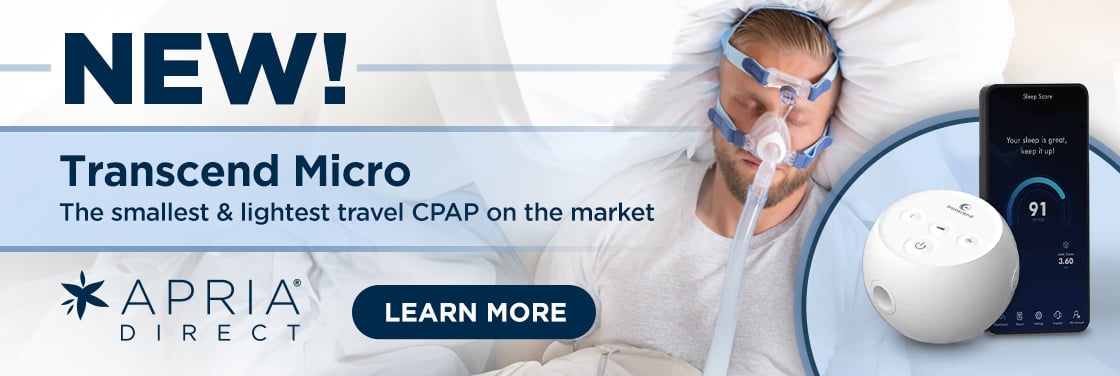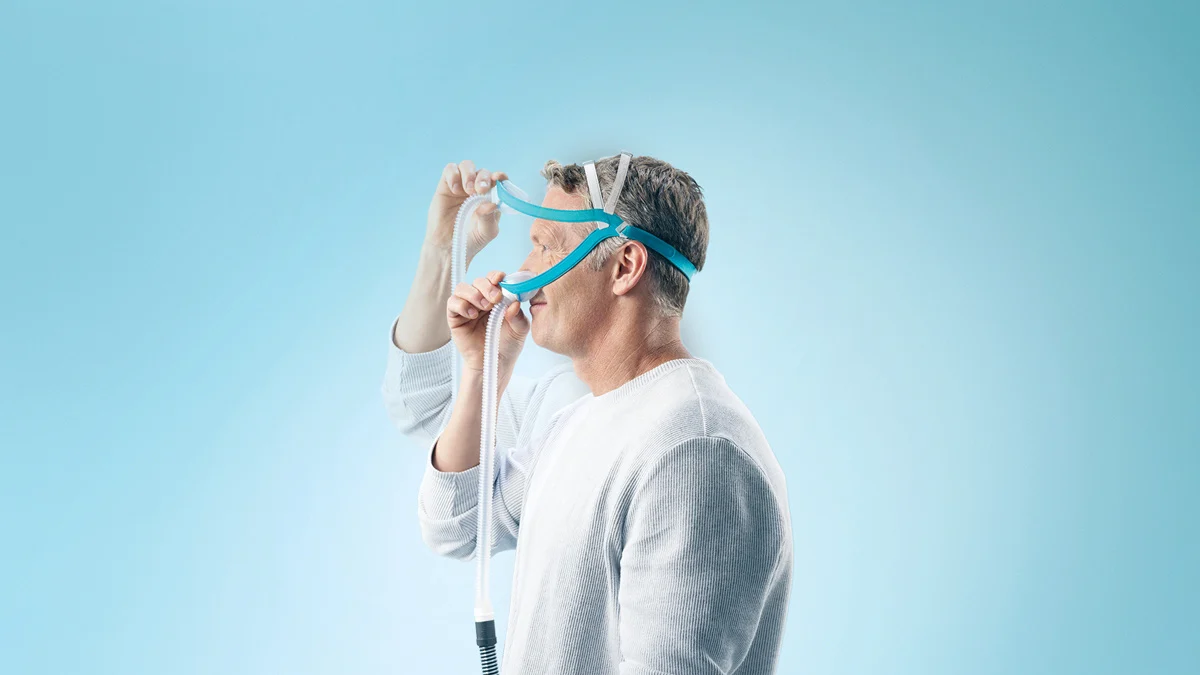These Easy Exercises Strengthen Airway Muscles to Help Reduce Snoring and Other Symptoms.
Fact of life: everybody snores. Men, women, children, adults. Normally, mild snoring is nothing to worry about.
But if you snore heavily three or more nights each week—frequently gasping for air and waking up—you may have sleep apnea.
Snoring due to sleep apnea occurs when the normal flow of air through your mouth or nose is obstructed during sleep. Air moves past tissues at the back of the throat, causing them to vibrate—and causing you to snore.
Says Robert Miller, Apria Healthcare Vice President of Sleep Business, “Obstructed airways keep your body from getting the oxygen it needs, which makes your heart work harder. As a result, sleep apnea can lead to serious health conditions like stroke, heart disease, and high blood pressure.”
That’s why it’s important to reduce snoring, which can help you better manage sleep apnea. The question is: How?
The Answer: Myofunctional Therapy!
Mouth, jaw, tongue, nose, and throat exercises can strengthen the muscles around your airways, making snoring less frequent and noisy.
Plus, research reveals that myofunctional therapy can also help improve moderate sleep apnea.
Benefits of Myofunctional Therapy
- It’s one of the simplest solutions to help alleviate snoring and sleep apnea by targeting and strengthening muscles in your mouth, nose, tongue, and throat
- Also improves eating, chewing, swallowing, and talking
- May help people who suffer from neck pain, headaches, or poor digestion
- By reducing snoring, it improves the quality and quantity of sleep and decreases daytime fatigue
- Teaches you how to breathe through your nose and the proper position of your tongue against the roof of your mouth
- The exercises are easy to do and can be performed almost anywhere at any time
- No special equipment is needed
- No medical supervision is required while performing the exercises
Most sleep experts agree that the exercises recommended by your doctor should be performed at least 10 minutes a day for three months to gauge their effectiveness. Many people do them two to three times a day.
Following are the mouth, jaw, tongue, nose, and throat exercises you can do to tone the muscles around your airways.
Mouth Exercises
The Lip Pucker
Tightly purse your lips like you’re going to whistle. Hold for a few seconds, then release. Do this 10 times.
The Cheek Hook
Place your hooked index finger inside one cheek, then gently pull outward. As you do, use your cheek muscles to pull your cheek back in. Do this 10 times on each side of your mouth.
Jaw Exercises
The Jaw Stretch
Purse your lips and tightly close your mouth. Then relax your lips and jaw and open your mouth. Repeat 10 times.
The Side-to-Side Jaw Movement
Open your mouth wide and move your jaw from side to side. Adjust the opening of your mouth and continue moving your jaw from side to side. Repeat several times.
Tongue Exercises
The Tongue Push-Up
Place your tongue against the roof of your mouth and push up. Hold for 10 seconds, then repeat 5 times.
The Tongue Push-Down
Press the tip of your tongue against your bottom front teeth. Now, push the back of your tongue flat against the floor of your mouth. Hold 10 seconds and repeat 5 times.
The Tongue Slide
Press the tip of your tongue on the back of your upper front teeth, then slide your tongue back and forward along the roof of your mouth. Do this 5-10 times.
The Tongue Stretch
Here’s a simple exercise to increase tongue strength. Stick your tongue out as far as possible. Now, look up at the ceiling and then try to touch your chin with your tongue. Repeat 5 times.
The Tongue Curl
Stick your tongue out of your mouth, curl it into a tube, and hold for 5 seconds.
Nose Exercises
Breathing Through Your Nose
Use an index finger or knuckle to close your right nostril and breathe
in through your left nostril. Then close your left nostril with a finger or knuckle and breathe in through your right nostril. Repeat 5 times for each nostril.
Throat Exercises
Pronounce Vowel Sounds
Saying vowel sounds can help strengthen throat muscles.
Repeat the sounds a-e-i-o-u. Start by saying each normally, then adjust how long and fast you say each. starting with normal pronunciation and then adjusting the length and speed. Repeat the same vowel 10–20 times then move on to the next one.
Sing!
Research suggests that singing regularly can decrease the severity, frequency, and intensity of snoring and improve the symptoms of mild to moderate sleep apnea. So pick a song and sing, sing, sing!
Add CPAP for Greater Effectiveness
For decades, CPAP (continuous positive airway pressure) has been the tried-and-true therapy for managing sleep apnea.
Apria’s Robert Miller adds, “Clinical studies now show that people who perform myofunctional therapy to strengthen airway muscles also realize reduced snoring and milder sleep apnea symptoms when they use a CPAP machine.”
Exercise More, Snore Less
Myofunctional therapy has been proven to help reduce the severity and frequency of snoring as well as the symptoms of mild sleep apnea. But be patient – like any exercise routine, it takes time to build airway muscles in order to enjoy the full benefits. Also, consult with your doctor to create a myofunctional therapy exercise regimen tailored to your specific needs.
References
1. Suni, E. (Updated 2023, September 8). Mouth And Throat Exercises to Help Stop Snoring and Improve OSA. Sleep Foundation. https://www.sleepfoundation.org/snoring/mouth-exercises-to-stop-snoring.
2. Edwards, M. (Updated 2023, September 22). Mouth Exercises to Stop Snoring.
SleepApnea.org. https://www.sleepapnea.org/snoring/mouth-exercises-to-stop-snoring/.
3. 14 Convenient Exercises To Improve Chronic Snoring And Sleep Apnea. Florida Sinus & Snoring Specialists. https://www.southfloridasinusandallergy.com/14-convenient-exercises-to-improve-chronic-snoring-and-sleep-apnea/.
4. (2021, August 1). Exercises to Help with Snoring. Specialty Physician Associates. https://specialtyphysicianassociates.com/news/exercises-to-help-with-snoring/.
5. (Update 2018, August). Snoring, Sleeping Disorders, and Sleep Apnea. ENT Health. https://www.enthealth.org/conditions/snoring-sleeping-disorders-and-sleep-apnea/
LEGAL DISCLAIMER: Material in this newsletter is provided for general health education and informational purposes and to provide references to other resources only; it may not apply to you as an individual. While Apria Healthcare believes that the information provided through this communication is accurate and reliable, Apria Healthcare cannot and does not make any such guarantee. It is not intended to be a replacement for professional medical advice, evaluation, diagnosis, services or treatment (collectively, “medical treatment”). Please see your healthcare provider for medical treatment related to you and your specific health condition(s). Never disregard medical advice or delay seeking medical care because of something you have read on or accessed through this website. Reading this newsletter should not be construed to mean that you have a healthcare provider/patient relationship.


.png)



